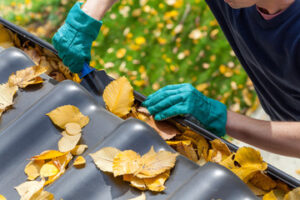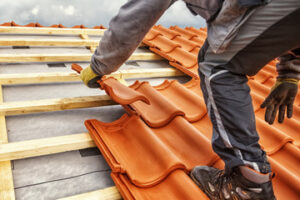Gutters protect your home from a host of damage, from basement flooding to mold growth and structural problems. Gutter cleaning is the key to keeping your gutters functioning properly.

Gutter cleaning keeps them clear of leaves, twigs and other debris that create breeding grounds for pests like mosquitoes. It also prevents soil erosion and the uprooting of plants. Visit https://www.stlouisguttercleaningservices.com/ to learn more.
If the idea of climbing a ladder and clawing gunk off your gutters by hand has you procrastinating on this annual chore, it’s time to upgrade to modern power tools. Specialized blower attachments make the process faster and more effective, reducing the risk of injuries or property damage. When used properly, these tools can also eliminate the need for ladders, saving you valuable time and effort.
Typically, these specialized nozzles attach to the end of a leaf blower and feature a curved portion that helps target and dislodge debris from the inside of gutters. The design of these attachments is crucial, as it balances power with precision for optimal results.
While a standard leaf blower is able to dislodge dry leaves, twigs, and pine needles from the inside of gutters, wet materials may be too heavy or sticky to be blown away. Gutter cleaning attachments can also be used to suck wet material into a bag or vacuum chamber for easy disposal.
Another option for removing debris from gutters is to use a high-powered water sprayer. This method is especially useful for clogged gutters, as it can dislodge and flush out stubborn blockages with minimal effort. The best water-sprayer nozzles feature adjustable nozzle settings that allow you to adjust the pressure for maximum effectiveness. It is important to note that these nozzles are not intended for use on roofs, so you should only use them when the gutters are completely empty and dry.
When using a water-sprayer, it is a good idea to wear a face mask and safety goggles for protection from spray and debris. In addition, it is a good idea to wear sturdy work gloves and long pants to protect against splash back from the pressure of the water. Depending on the size of your gutters, you might need to attach several water-sprayer nozzles to an extendable pole for increased reach.
Another way to eliminate the need for a ladder during gutter cleaning is by using a telescoping water wand with an adjustable nozzle. These wands can be attached to a regular garden hose and are designed to reach the top of a gutter. The wand is then used to direct water jets into each downspout, helping to remove dirt and sediment from the downspout and eliminating any standing water that might indicate a blocked drain.
Safety First
Gutter cleaning can be dangerous, especially for homeowners who aren’t experienced with working on roofs or scaling ladders. Every year, thousands of people are treated for ladder-related injuries and as many as 300 die. There are a few simple rules to follow to ensure safety:
Always survey your surroundings before climbing the ladder. Take note of nearby power and phone lines, tree branches, and weather conditions like wind or rain that could contribute to accidents. Also, make sure that the ladder is placed on a stable surface and not leaning against or resting on anything.
Next, wear appropriate footwear and a pair of sturdy gloves. The best pair will be thick and rubbery, at least water resistant if not waterproof, to protect your hands from the rotten sludge inside gutters that is full of bird feces, squirrel droppings, and other nasty things crawling with bacteria. The gloves are also important to protect your hands from twisted bits of metal or wire that can be hiding in the debris. Eye protection is a must as well, as you may experience splashback from the gutters.
Once you are up on the ladder, start by raking or power washing the roof before moving onto the gutters. This will help prevent the loosened debris from falling off of the roof as you work and it will make it easier to scoop the gunk away. It’s also a good idea to have a bucket or bag attached to the ladder to catch the debris as you go. This will prevent it from falling to the ground where it can create slip hazards or require extra cleanup later.
Once you’ve removed the bulk of the debris, use a hose with a pistol handle to rinse away remaining gunk and clogs. Be careful to avoid spraying hose over the shingles or near heating, ventilation, and air conditioning (HVAC) vents as this can damage them and cause leaks. If the hose isn’t strong enough to break up a stubborn clog, a plumber’s auger may be needed. After the clog is cleared, be sure to clean up any remaining debris and place downspout covers over drain outlets to prevent future clogs. It’s also a good idea for homeowners to clean their gutters on a regular schedule, at least once in the spring and fall. Consistent maintenance will keep the gutters clean and clog-free, reducing the need for manual cleaning or high-powered blowers.
Efficiency
Gutter cleaning is a vital component of regular home maintenance, helping safeguard the structural integrity of your home from costly damages. Neglecting gutters can result in a host of issues, from roof damage and basement flooding to unsightly water marks along the exterior walls of your house. Consequently, homeowners must decide whether to climb a ladder and take on this project themselves or opt for professional services.
Climbing a ladder, delving into your gutters and manually extricating all that debris is an arduous, time-consuming, and potentially dangerous endeavor. Additionally, the initial investment in equipment, such as a ladder, gutter scoops, and a leaf blower, may negate any perceived financial savings.
A seasoned technician, however, can efficiently tackle this chore using specialized tools and expertise. A comprehensive inspection is performed prior to beginning the cleaning process, identifying trouble spots and the extent of debris accumulation. Once the inspection is complete, the technician mounts a ladder and begins the work, unleashing a powerful burst of air that dislodges leaves, twigs, and built-up sediment. The powerful airstream also moves through downspouts, clearing any blockages and restoring optimal water flow. Once the work is complete, a ground crew gathers any remaining debris and responsibly disposes of it.
Homeowners can help streamline the cleaning process by preparing their gutter system before service is scheduled. This includes ensuring that the area around the gutters is clear of obstacles and impediments, trimming any overhanging branches, and securely securing outdoor furniture. It is also helpful to communicate any specific concerns or areas of concern to the service team beforehand, which will enable them to pay special attention to those locations during their inspection. This foresight not only helps to expedite the cleaning process, but also ensures that your gutters are properly cleaned and safeguarded against future damage.
Preparation
In addition to operational setup, a successful gutter cleaning business must focus on building a solid client base and providing high-quality service to ensure the health of the business. Effective marketing strategies and client acquisition methods can help establish a competitive edge in the market. Additionally, a strong emphasis on client service will allow the company to attract repeat customers and build a solid reputation in the industry.
As a result, it is important to hire and manage skilled staff who can handle the demands of the job. The training process must be thorough, and employees should be well-versed in safety protocols. Furthermore, it is essential to provide ongoing support and assistance to new hires, as this will help them quickly adapt to the responsibilities of the job and achieve optimal performance levels.
Gutter cleaning is a critical protective measure, ensuring rainwater is efficiently channeled away from the roof and foundation of the home. Regular cleaning prevents the accumulation of debris like leaves, twigs, dirt, and other contaminants that can infiltrate the gutters and downspouts, resulting in clogs that block the flow of water and leading to flooding and structural damage.
Before beginning a gutter cleaning project, it is important to clear the area around the home of any obstacles or impediments that can hinder access to the gutters. This can be accomplished by removing outdoor furniture, moving potted plants, and trimming back any overhanging branches. This will also enable technicians to get a good look at the gutters, identify potential trouble spots, and complete a thorough inspection of the gutter system.
The cleaning process itself typically begins with a vacuuming of the gutters and downspouts. The nozzle is moved along the gutters, dislodging and washing away debris from the roof and siding. The nozzle is also directed into the downspouts to clear out any clogs. The gutters are then flushed and inspected to ensure they are completely free of debris.
In some cases, additional services may be offered, such as testing underground drains, bagging debris, or removing and reinstalling gutter guards. The price for these services can vary based on the size of the home, the number of stories, and the extent of the debris. In addition, homeowners in wooded areas can expect to pay a higher rate due to the increased risk of debris accumulation in the gutters.
